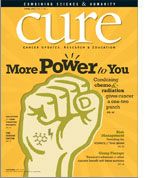Publication
Article
CURE
ACS Proposes New Lung Cancer Screening Guidelines
Author(s):
The cancer organization proposes new screening guidelines for lung cancer.
More than a year after a large clinical trial determined that screening with low-dose computed tomography (CT) could modestly reduce the overall risk of lung cancer deaths in current and former smokers, the American Cancer Society (ACS) has proposed new screening guidelines for physicians and the public.
The hope is that by screening a high-risk population—still smoking or with heavy smoking histories—this 3-D technology could pick up lung cancers early enough to alter the 13 to 15 percent five-year survival rate. In the National Lung Screening Trial (NLST), which compared CT screening to standard chest X-rays in high-risk individuals, 443 out of 143,368 patients who received X-rays died of the disease compared with 356 out of 144,103 who received CT screening. Researchers estimated it would take 320 CT scans to save one life.
Lung cancer is difficult to detect early. More than 160,000 men and women were expected to die of the disease in 2012, making it the deadliest cancer, according to the ACS.
But, while experts believe that CT scanning holds promise for early detection, they acknowledge the technology is not without risks: it had a high false-positive rate, leading to unnecessary needle biopsies, bronchoscopies and even open lung surgery. Sixteen patients who underwent CT scanning died within 60 days of one of the procedures, including six individuals who did not have cancer.
“To put this into perspective, the six deaths were out of over 17,000 positive screens,” says Denise Aberle, a co-principal investigator in the NLST study and a professor of radiology and bioengineering at the University of California, Los Angeles. “But there are risks to screening.”
Aberle says the potential benefit of “stage-shifting” in lung cancer from advanced to early, more treatable disease, outweighs such risks.
I don’t think it’s right to recommend lung cancer screening to just anyone...But people who would qualify for the NLST and who are enormously worried about their lung cancer risk might do this.
Some medical groups have adopted new guidelines, recommending that asymptomatic heavy smokers and former smokers talk to their doctors about undergoing annual low-dose CT screening.
“From my perspective, we’re [reading from] the same script as mammography 30 years ago when many women paid out of pocket to get these tests,” says Francine Jacobson, a radiologist at Brigham and Women’s Hospital and an NLST researcher. “It’s an expensive test, but it’s far more expensive to let people die of advanced lung cancer.”
Although false positives do frequently occur, she concedes, “on the flip side we did find things that were life-saving,” such as aortic aneurysms ready to burst or renal carcinomas picked up as part of these scans. Additionally, researchers have collected more than 10,000 specimens for future research on biomarker identification, which could render CT screening obsolete for another generation, Jacobson adds.
In the meantime, WellPoint announced in 2011 it would cover CT screening in high-risk individuals. And other private insurers, such as Blue Cross and Blue Shield, and also Medicare are evaluating the NLST evidence, along with assurances smoking cessation efforts would be directed at those who still smoke.
“The worst thing would be if smokers use these screens as [an excuse] to continue smoking,” says Otis W. Brawley, chief medical and science officer of the ACS. Also of concern, he says, are aggressive marketing tactics used by some hospitals, encouraging even nonsmoking women in their 40s to get screened. “I don’t think it’s right to recommend lung cancer screening to just anyone,” Brawley says. “But people who would qualify for the NLST and who are enormously worried about their lung-cancer risk might do this.”
If they do, the consensus among experts is that these tests should be done with patients fully informed of the risks and benefits, and at specialized centers offering a multidisciplinary approach and established protocols for diagnosing and removing suspicious lesions.
“This is another huge issue for us,” Brawley says. “The people who gave us 87 saved lives (in the CT screening arm) were from the best places in the country.”






